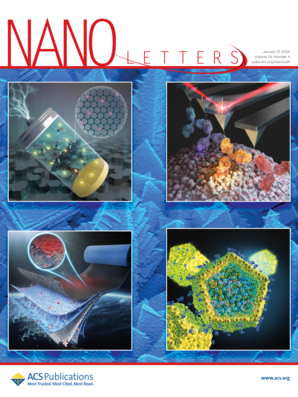Narrow Blue Emission from Cadmium Phosphide Clusters Enhanced through Phosphinate Ligation
IF 9.6
1区 材料科学
Q1 CHEMISTRY, MULTIDISCIPLINARY
引用次数: 0
Abstract
The atomic precision of magic-sized clusters offers a route toward narrow emission by eliminating heterogeneous broadening. Herein, we report ultranarrow 467 nm blue emission from cadmium phosphide clusters with a 96 meV line width and as high as 26% photoluminescence quantum yield (PLQY) enabled by tightly bound, bidentate phosphinate ligands. They are obtained through postsynthetic ligand exchange from oleate-capped clusters. The phosphinate maintains the bidentate coordination motif, which does not disturb the metastability of the material but does induce a change in the surface dipole, causing a bathochromic shift in the emission from 457 to 467 nm, which is an optimal wavelength for blue emission. We find that the structure of the ligand tail can heavily influence PLQY and other aspects of the charge carrier dynamics. The ligand exchange protocol can be applied to the related cadmium arsenide clusters, resulting in a narrow 550 nm green emission with a 9% PLQY.

膦酸盐结扎增强磷化镉团簇窄蓝光发射
魔术大小的星团的原子精度通过消除异质展宽为窄发射提供了一条途径。本文中,我们报道了由紧密结合的双齿膦酸配体实现的磷化镉团簇的超467 nm蓝光发射,其线宽为96 meV,光致发光量子产率高达26%。它们是通过合成后的配体交换从油酸盖簇中获得的。磷酸盐保持双齿配位基序,这不会干扰材料的亚稳性,但会引起表面偶极子的变化,导致发射从457 nm到467 nm的色移,这是蓝色发射的最佳波长。我们发现配体尾部的结构会严重影响PLQY和载流子动力学的其他方面。配体交换协议可以应用于相关的砷化镉簇,产生窄的550 nm绿色发射,PLQY为9%。
本文章由计算机程序翻译,如有差异,请以英文原文为准。
求助全文
约1分钟内获得全文
求助全文
来源期刊

Nano Letters
工程技术-材料科学:综合
CiteScore
16.80
自引率
2.80%
发文量
1182
审稿时长
1.4 months
期刊介绍:
Nano Letters serves as a dynamic platform for promptly disseminating original results in fundamental, applied, and emerging research across all facets of nanoscience and nanotechnology. A pivotal criterion for inclusion within Nano Letters is the convergence of at least two different areas or disciplines, ensuring a rich interdisciplinary scope. The journal is dedicated to fostering exploration in diverse areas, including:
- Experimental and theoretical findings on physical, chemical, and biological phenomena at the nanoscale
- Synthesis, characterization, and processing of organic, inorganic, polymer, and hybrid nanomaterials through physical, chemical, and biological methodologies
- Modeling and simulation of synthetic, assembly, and interaction processes
- Realization of integrated nanostructures and nano-engineered devices exhibiting advanced performance
- Applications of nanoscale materials in living and environmental systems
Nano Letters is committed to advancing and showcasing groundbreaking research that intersects various domains, fostering innovation and collaboration in the ever-evolving field of nanoscience and nanotechnology.
 求助内容:
求助内容: 应助结果提醒方式:
应助结果提醒方式:


